LEGO Rock Raiders (video game): Difference between revisions
→Development: pages |
No edit summary |
||
| Line 308: | Line 308: | ||
== Development == | == Development == | ||
''LEGO Rock Raiders'' was developed by [[Data Design Interactive]], a British video game developer based in [[Wikipedia:Halesowen|Halesowen]], near [[Wikipedia:Birmingham|Birmingham]].<ref name="World Club memo"/> Development began in October 1997, shortly after the release of ''[[LEGO Island]]'', when [[LEGO Media International]] approached Data Design to create it.<ref name="World Club memo"/><ref name="Animation World"/> LEGO Media presented concepts for the then-upcoming LEGO Rock Raiders theme to the developers at Data Design, including ideas for the theme's characters, buildings, vehicles, creatures, and story. | ''LEGO Rock Raiders'' was developed by [[Data Design Interactive]], a British video game developer based in [[Wikipedia:Halesowen|Halesowen]], near [[Wikipedia:Birmingham|Birmingham]].<ref name="World Club memo"/> Development began in October 1997, shortly after the release of ''[[LEGO Island]]'', when [[LEGO Media International]] approached Data Design to create it.<ref name="World Club memo"/><ref name="Animation World"/> LEGO Media presented concepts for the then-upcoming LEGO Rock Raiders theme to the developers at Data Design, including ideas for the theme's characters, buildings, vehicles, creatures, and story.{{r|BNB28|p=9}} At the time, Data Design had recently finished development on [[Wikipedia:Conquest Earth|''Conquest Earth'']], a [[Wikipedia:Strategy video game|strategy game]] made for Eidos Interactive.<ref name="Conquest Earth date"/> The developers were looking to create another strategy game, and decided that the LEGO Rock Raiders storyline would work best as one.{{r|BNB28|pp=2, 9}} | ||
LEGO Media was heavily involved in the development of ''LEGO Rock Raiders''. | LEGO Media was heavily involved in the development of ''LEGO Rock Raiders''.{{r|BNB28|p=10}} Tomas Gillo, the head of concept development at LEGO Media,<ref name="CGW"/> became the game's senior producer.<ref name="PC manual credits"/> David Upchurch, a producer for other LEGO Media titles, frequently visited Data Design for a week at a time to play through the game and give the developers feedback.{{r|BNB28|p=10}} The project was managed on Data Design's end by Eamonn P. Barr, with founder Stewart Green credited as executive producer.<ref name="PC manual credits"/> | ||
=== Conception and design === | === Conception and design === | ||
| Line 319: | Line 319: | ||
The unified development process of the toys and game led to some design issues, according to head artist Rob Dorney. Early in the game's design process, LEGO Futura would send storyboards and prototype LEGO models to the game's developers, who would give feedback on what worked with their vision for the game and make suggestions when ideas didn't work. Both groups often did not receive finalised model designs from the other until late in development.<ref name="CGW"/> Although the LEGO Rock Raiders construction sets took only eight months to develop,<ref name="Ultimate Design"/> the game's design process ended up lasting for around eighteen months, longer than usual for Data Design Interactive, as both groups had to adjust elements on their ends to create a cohesive product between the video game and LEGO sets. Despite these issues, the "parallel" development of the project was considered a success.<ref name="CGW"/> | The unified development process of the toys and game led to some design issues, according to head artist Rob Dorney. Early in the game's design process, LEGO Futura would send storyboards and prototype LEGO models to the game's developers, who would give feedback on what worked with their vision for the game and make suggestions when ideas didn't work. Both groups often did not receive finalised model designs from the other until late in development.<ref name="CGW"/> Although the LEGO Rock Raiders construction sets took only eight months to develop,<ref name="Ultimate Design"/> the game's design process ended up lasting for around eighteen months, longer than usual for Data Design Interactive, as both groups had to adjust elements on their ends to create a cohesive product between the video game and LEGO sets. Despite these issues, the "parallel" development of the project was considered a success.<ref name="CGW"/> | ||
The development team attempted to balance the gameplay of ''LEGO Rock Raiders'' to be challenging and fun while still being easy and accessible enough for young children to play. The inherent complexity of strategy games and the younger target audience of both the game and the LEGO Rock Raiders sets made finding this balance a challenge for the developers. The team designed the game to introduce players to new features gradually enough that they could improve their gameplay skills and prepare for later challenges without feeling overwhelmed. | The development team attempted to balance the gameplay of ''LEGO Rock Raiders'' to be challenging and fun while still being easy and accessible enough for young children to play. The inherent complexity of strategy games and the younger target audience of both the game and the LEGO Rock Raiders sets made finding this balance a challenge for the developers. The team designed the game to introduce players to new features gradually enough that they could improve their gameplay skills and prepare for later challenges without feeling overwhelmed.{{r|BNB28|p=10}} | ||
The designers were not allowed to show any serious injuries, and could not make the game too violent or creepy. "We were very aware of the audience and of how violence is seen within the LEGO world," developer Karl White said in 2021. | The designers were not allowed to show any serious injuries, and could not make the game too violent or creepy. "We were very aware of the audience and of how violence is seen within the LEGO world," developer Karl White said in 2021.{{r|BNB28|p=10}} Playable units in the game have [[Wikipedia:Health (game terminology)|health]] indicators (described in the manual as protective [[Wikipedia:Force field (technology)|force fields]] or "Shields" surrounding them),<ref name="PC manual p58"/> and Rock Raiders are safely teleported and back to the LMS ''Explorer'' when their health runs too low, rather than receiving any harm.{{r|BNB28|p=10}} Despite this, players still felt a sense of attachment to their Rock Raiders and a fear of loss, according to White.{{r|BNB28|p=2}} Creatures in the game also were revised multiple times to be appropriate for the game's target audience, and were designed to never be killed or destroyed, instead being pushed away by the player and eventually leaving.{{r|BNB28|p=10}} | ||
=== Art and graphics === | === Art and graphics === | ||
| Line 337: | Line 337: | ||
=== Sound and music === | === Sound and music === | ||
The characters in the game were voiced by Data Design Interactive employees. [[Chief]] was voiced by the game's project manager, while [[Jet]] was voice by the studio's office coordinator. | The characters in the game were voiced by Data Design Interactive employees. [[Chief]] was voiced by the game's project manager, while [[Jet]] was voice by the studio's office coordinator.{{r|BNB28|p=11}} | ||
Three music tracks were composed by Marl Boonyer{{efn|Credited as Mark Boobyer.}} and produced by Alan Boorman in 1998.<ref name="PC manual credits"/><ref name="bandcamp archive Aug"/> | Three music tracks were composed by Marl Boonyer{{efn|Credited as Mark Boobyer.}} and produced by Alan Boorman in 1998.<ref name="PC manual credits"/><ref name="bandcamp archive Aug"/> | ||
| Line 344: | Line 344: | ||
''LEGO Rock Raiders'' was first publicly announced on 10 February 1999, along with [[LEGO Racers (video game)|''LEGO Racers'']], [[LEGO Friends (1999 video game)|''LEGO Friends'']], and [[LEGOLAND (video game)|''LEGOLAND'']]. It was initially scheduled for release on Microsoft Windows and PlayStation in September 1999, with a planned retail price of US$40–$45.<ref name="cdmag announces"/><ref name="IGN Snap"/> It and ''LEGO Racers'' were intended to be the first LEGO video games for PlayStation,<ref name="cdmag announces"/> and the first console LEGO games since ''[[LEGO Fun to Build]]'' in 1995.{{citation needed}} In May 1999 all four titles were displayed for demonstration at [[Wikipedia:E3 1999|E3 1999]] in [[Wikipedia:Los Angeles|Los Angeles]], at the LEGO Media booth #1524 in the South Hall. A large LEGO model of the character [[Jet]] driving a [[Hover Scout]] was built by model designers from [[LEGO Systems]] during the event. Models of [[Rocket Racer|Rocket Racer's]] car from ''LEGO Racers'' and of [[Wikipedia:PlayStation controller|PlayStation]] and [[Wikipedia:Nintendo 64 controller|Nintendo 64]] controllers were also displayed at the LEGO Media booth; the controller models were given to the winners of a contest involving the car model.<ref name="cdmag E3"/><ref name="IGN E3"/> | ''LEGO Rock Raiders'' was first publicly announced on 10 February 1999, along with [[LEGO Racers (video game)|''LEGO Racers'']], [[LEGO Friends (1999 video game)|''LEGO Friends'']], and [[LEGOLAND (video game)|''LEGOLAND'']]. It was initially scheduled for release on Microsoft Windows and PlayStation in September 1999, with a planned retail price of US$40–$45.<ref name="cdmag announces"/><ref name="IGN Snap"/> It and ''LEGO Racers'' were intended to be the first LEGO video games for PlayStation,<ref name="cdmag announces"/> and the first console LEGO games since ''[[LEGO Fun to Build]]'' in 1995.{{citation needed}} In May 1999 all four titles were displayed for demonstration at [[Wikipedia:E3 1999|E3 1999]] in [[Wikipedia:Los Angeles|Los Angeles]], at the LEGO Media booth #1524 in the South Hall. A large LEGO model of the character [[Jet]] driving a [[Hover Scout]] was built by model designers from [[LEGO Systems]] during the event. Models of [[Rocket Racer|Rocket Racer's]] car from ''LEGO Racers'' and of [[Wikipedia:PlayStation controller|PlayStation]] and [[Wikipedia:Nintendo 64 controller|Nintendo 64]] controllers were also displayed at the LEGO Media booth; the controller models were given to the winners of a contest involving the car model.<ref name="cdmag E3"/><ref name="IGN E3"/> | ||
The game launched for Windows in November 1999. | The game launched for Windows in November 1999.{{r|BNB28|p=11}} LEGO Media announced the game's release and availability on 18 November.<ref name="GC release"/> [[Wikipedia:IGN|''IGN'']] listed the game's release date as 15 November.{{R|IGN review}} [[Wikipedia:GameSpot|''GameSpot'']] listed a later release date of 30 November.{{R|gamespot review}} | ||
=== Soundtrack === | === Soundtrack === | ||
| Line 429: | Line 429: | ||
{{refbegin}} | {{refbegin}} | ||
* McPhail, Jim (13 December 1999). [https://archive.org/details/LEGORockRaiders-manual-Win-EU-2299598/mode/1up?view=theater ''LEGO Rock Raiders'' Instruction Manual (UK FRONT, BACK, I/F & I/B COVER)]. [[LEGO Media International]]. Serial: IB2G-ROC3 2299598. | * McPhail, Jim (13 December 1999). [https://archive.org/details/LEGORockRaiders-manual-Win-EU-2299598/mode/1up?view=theater ''LEGO Rock Raiders'' Instruction Manual (UK FRONT, BACK, I/F & I/B COVER)]. [[LEGO Media International]]. Serial: IB2G-ROC3 2299598. | ||
* Data Design Interactive (last modified 25 September 1999). [[ | * Data Design Interactive (last modified 25 September 1999). [[Main Lego Config File]]. File path: <samp>Rock Raiders\LegoRR1.wad\Lego.cfg</samp>. | ||
{{refend}} | {{refend}} | ||
Revision as of 14:26, 27 August 2023
LEGO Rock Raiders is a 1999 real-time strategy video game developed by Data Design Interactive and published by LEGO Media International. The game is based on and was developed alongside the LEGO theme of the same name.
Gameplay
The Windows version of LEGO Rock Raiders is a mission-based real-time strategy game with elements of construction simulation.[1][2] The game takes place in 3D underground environments and is played from an overhead view that can be freely rotated and zoomed.[3][4] The player commands a team of space-faring miners, the eponymous Rock Raiders, through a series of missions where they mine for resources, build up underground bases, and avoid natural hazards and alien creatures.[5][1]
The game is primarily controlled with the mouse pointer, which can pan the camera around and interact with the virtual world as well as the game’s interface. [1][6] The player can click on individual units to select them, or click and drag to draw a box that will select any units inside it. Selected units can be directly ordered by clicking where the player wants them to go or clicking menu icons.[1][5][7]
Buildings
Buildings in LEGO Rock Raiders serve a wide variety of functions, including storing materials, powering other buildings, teleporting down vehicles, and training Rock Raiders.
Most missions start the player with a Tool Store, which is required to construct all other buildings.[8] Some missions may have additional buildings already constructed at the start. In most missions the player is able to construct additional buildings,
The game uses a simple building-based technology tree system, referred to as dependency, where certain buildings must be constructed and upgraded before other buildings and vehicles can be teleported.[9][2]
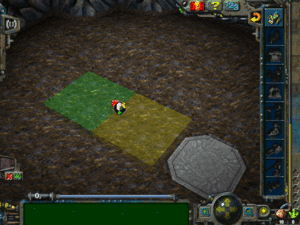
Buildings can be constructed by clicking the Buildings icon to open the Buildings Menu.[10] Hovering the mouse pointer over a specific building's icon will display a set of icons listing its dependency. Dependency icons that are greyed out mean that the unit is missing or has not been upgraded enough.[1][9] Clicking on a building's icon will make it active for construction; coloured highlights will then appear over blocks at the player's mouse pointer, indicating the size and layout of the building. Moving the pointer around will move and rotate the building's layout highlight in the world, changing the colours of each block to indicate its position and whether it can be constructed at that location. Green blocks designate the solid area of the building, while yellow blocks show its entrance path (the Docks also has a blue block for its water entrance). Red blocks indicate that the construction location is invalid or blocked, while purple blocks indicate that the ground is too uneven to build on. Buildings must be constructed next to Power Paths, with at least one entrance block (if the building has any) adjacent to a Power Path. Once a valid location has been found, clicking on the ground at that location will place its foundation so that construction can begin.[10][2]
With the exception of the Tool Store, buildings require resources and barriers to be constructed. Barriers, which are dispensed from the Tool Store, are placed in a perimeter around the building site, and resources are placed within this perimeter. Rock Raiders will automatically carry barriers and resources to a building site and place them there. Hovering the mouse pointer over the construction site will bring up a tooltip showing how many Energy Crystals and Ore are needed. Once all of a building's required resources and barriers have been placed, LEGO pieces will teleport down and assemble into the building. [9][1]
Most of the game's buildings can be upgraded at least once, up to a maximum of three times. All building upgrades cost five pieces of Ore or one Building Stud. Many building upgrades unlock other buildings and vehicles, while others improve the function of the building being upgraded.[9] For instance, upgrading the Tool Store once unlocks the Teleport Pad for construction, while upgrading the Ore Refinery reduces the amount of Ore it requires to create a Building Stud.[8][11] A building can be upgraded by clicking on it to bring up its Building Maintenance Menu, then clicking the Upgrade Building icon.[9]
The table below lists the buildings in the game in the order they are in the Buildings Menu. Each building's entry includes an image from the game's instruction manual (not always accurate to its in-game appearance), requirements and upgrades for each building, and a brief description.
| Building | Shape | Cost | Dependency | Upgrades |
|---|---|---|---|---|
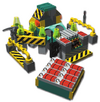 Tool Store |
None | Rock Raider | 2 Levels | |
| The Tool Store is the first building the player will start with in missions, and is required for all other buildings and vehicles. It can teleport down Rock Raiders and supply them with tools and construction materials, and stores any collected Energy Crystals and Ore. Rock Raiders can upgrade at it, allowing them to carry more tools. Upgrading the Tool Store to Level 1 unlocks the Teleport Pad. Upgrading it to Level 2 allows Rock Raiders to train as Explosives Experts at it. | ||||
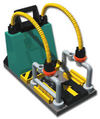 Teleport Pad |
8 Ore (2 Building Studs) | Rock Raider, Tool Store (L1) | 2 Levels | |
| The Teleport Pad can teleport down Rock Raiders and Small Vehicles (except for the Rapid Rider). Rock Raiders can train as Pilots at it. Although it is the first building unlocked after the Tool Store, it requires power to function, and the Support Station must be constructed before it can teleport down the the Hover Scout, Small Digger, and Small Transport Truck. Upgrading it to Level 1 unlocks the Docks and Power Station. Upgrading it to Level 2 is required to teleport down the Small Mobile Laser Cutter and Tunnel Scout. | ||||
 Docks |
1 Energy Crystal, 8 Ore (2 Building Studs) | Rock Raider, Tool Store (L1), Teleport Pad (L1) | None | |
| The Docks is used to teleport down water-based vehicles. It must be built next to water. Rock Raiders can train as Sailors at it. While it can teleport down the Rapid Rider once it is powered,a Level 2 Support Station and Level 1 Super Teleport are required before it can teleport down the Cargo Carrier. | ||||
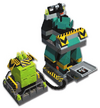 Power Station |
2 Energy Crystals, 12 Ore (3 Building Studs) | Rock Raider, Tool Store (L1), Teleport Pad (L1) | 1 Level | |
| The Power Station supplies power to all other buildings connected to it via Power Paths. Additionally, Electric Fences can be placed once it has been constructed. Upgrading it to Level 1 unlocks the Support Station, Upgrade Station, Geological Center, and Ore Refinery. | ||||
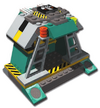 Support Station |
3 Energy Crystals, 15 Ore (3 Building Studs) | Rock Raider, Tool Store (L1), Teleport Pad (L1), Power Station (L1) | 2 Levels | |
| The Support Station refills the air supply in missions where it can run out. One Support Station can produce enough air for ten Rock Raiders. Rock Raiders can train as Drivers at it, and will also automatically go to it to eat when they are hungry. Upgrading it to Level 1 unlocks the Mining Laser and Super Teleport. Upgrading it to Level 2 is required to teleport down Large Vehicles at the Super Teleport. | ||||
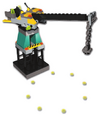 Upgrade Station |
3 Energy Crystals, 20 Ore (4 Building Studs) | Rock Raider, Tool Store (L1), Teleport Pad (L1), Power Station (L1) | 1 Level | |
| The Upgrade Station can upgrade vehicles. Rock Raiders can train as Engineers at it. Upgrading it to Level 1 halves the amount of time it takes for it to upgrade vehicles. | ||||
 Geological Center |
3 Energy Crystals, 15 Ore (3 Building Studs) | Rock Raider, Tool Store (L1), Teleport Pad (L1), Power Station (L1) | 2 Levels | |
| The Geological Center scans a much larger area than Rock Raiders and vehicles can. Rock Raiders can train as Geologists at it. It can be upgraded twice to increase its scanner range up to double its original scanning radius. | ||||
 Ore Refinery |
3 Energy Crystals, 20 Ore (4 Building Studs) | Rock Raider, Tool Store (L1), Teleport Pad (L1), Power Station (L1) | 3 Levels | |
| The Ore Refinery processed Ore into Building Studs. Five pieces of Ore create one Building Stud. It can be upgraded three times to decrease the amount of Ore required to four, three, and finally two pieces per Building Stud. | ||||
 Mining Laser |
1 Energy Crystal, 15 Ore (3 Building Studs) | Rock Raider, Tool Store (L1), Teleport Pad (L1), Power Station (L1), Support Station (L1) | 1 Level | |
| The Mining Laser is a tower with a laser that can cut through rock walls. Four laser blasts drain one Energy Crystal. Click on the building while it is already selected to enter or exit firing mode. Upgrading it adds a second laser. | ||||
 Super Teleport |
2 Energy Crystals, 20 Ore (4 Building Studs) | Rock Raider, Tool Store (L1), Teleport Pad (L1), Power Station (L1), Support Station (L1) | 1 Level | |
| The Super Teleport can teleport down Large Vehicles (except for the Cargo Carrier). A Level 2 Support Station is required before it can teleport down the Loader Dozer and Granite Grinder. Upgrading it to Level 1 is required to teleport down the Large Mobile Laser Cutter, Chrome Crusher, and Cargo Carrier. | ||||
Vehicles
| Vehicle | Cost | Dependency | Upgrades |
|---|---|---|---|
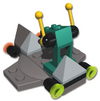 Hover Scout |
1 Energy Crystal | Rock Raider, Tool Store (L1), Teleport Pad (L1), Power Station (L1), Support Station | Engine (10 Ore), Scanner (5 Ore) |
| The Hover Scout is a small vehicle that can move over land quickly for reconnaissance. Rock Raiders must be trained as Drivers to use it. | |||
 Small Digger |
1 Energy Crystal | Rock Raider, Tool Store (L1), Teleport Pad (L1), Power Station (L1), Support Station | Engine (10 Ore), Drill (10 Ore), Scanner (5 Ore) |
| The Small Digger is a small drilling vehicle with two chainsaw blades that can cut through rock walls faster than a Rock Raider. Rock Raiders must be trained as Drivers to use it. | |||
 Small Transport Truck |
2 Energy Crystals | Rock Raider, Tool Store (L1), Teleport Pad (L1), Power Station (L1), Support Station | Engine (10 Ore), Scanner (5 Ore), Cargo Hold (5 Ore) |
| The Small Transport Truck is a small vehicle that can carry resources faster than a Rock Raider on foot. Rock Raiders must be trained as Drivers to use it. | |||
 Rapid Rider |
2 Energy Crystals | Rock Raider, Tool Store (L1), Teleport Pad (L1), Docks, Power Station | None |
| The Rapid Rider is a small water-based vehicle that can be used to explore underground rivers and lakes and carry small amounts of cargo across water. Rock Raiders must be trained as Sailors to use it. | |||
 Small Mobile Laser Cutter |
3 Energy Crystals | Rock Raider, Tool Store (L1), Teleport Pad (L2), Power Station (L1), Support Station (L1) | Drill (10 Ore) |
| The Small Mobile Laser Cutter is a small vehicle with a laser that can cut through rock walls. Rock Raiders must be trained as Drivers to use it. Two laser blasts drain one Energy Crystal. Click on the vehicle while it is already selected to enter or exit firing mode. | |||
 Tunnel Scout |
3 Energy Crystals | Rock Raider, Tool Store (L1), Teleport Pad (L2), Power Station (L1), Support Station (L1) | None |
| The Tunnel Scout is a small flying vehicle that can travel over land, water, and lava at high speeds. It is the only vehicle in the game that can cross lava. Rock Raiders must be trained as Pilots to use it. | |||
 Loader Dozer |
4 Energy Crystals | Rock Raider, Tool Store (L1), Teleport Pad (L1), Power Station (L1), Support Station (L2), Super Teleport | Engine (20 Ore), Scanner (5 Ore), Cargo Hold (5 Ore) |
| The Loader Dozer is a large bulldozer that can clear rubble much faster than Rock Raiders with shovels. Rock Raiders must be trained as Drivers to use it. | |||
 Granite Grinder |
3 Energy Crystals | Rock Raider, Tool Store (L1), Teleport Pad (L1), Power Station (L1), Support Station (L2), Super Teleport | Engine (20 Ore), Drill (20 Ore), Scanner (5 Ore) |
| The Granite Grinder is a large drilling vehicle with legs instead of wheels. It can drill through Dirt and Loose Rock faster than the Small Digger, though it drills Hard Rock at the same speed. Rock Raiders must be trained as Drivers to use it. | |||
 Large Mobile Laser Cutter |
4 Energy Crystals | Rock Raider, Tool Store (L1), Teleport Pad (L1), Power Station (L1), Support Station (L2), Super Teleport (L1) | Drill (25 Ore), Scanner (5 Ore) |
| The Large Mobile Laser Cutter is a large vehicle with a laser that can cut through rock walls. Rock Raiders must be trained as Drivers to use it. Four laser blasts drain one Energy Crystal. Click on the vehicle while it is already selected to enter or exit firing mode. | |||
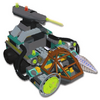 Chrome Crusher |
5 Energy Crystals | Rock Raider, Tool Store (L1), Teleport Pad (L1), Power Station (L1), Support Station (L2), Super Teleport (L1) | Engine (15 Ore), Drill (20 Ore) |
| The Chrome Crusher is a large mining vehicle with both a drill and a laser. It can mine through all types of rock walls very quickly. Rock Raiders must be trained as Drivers to use it. Four laser blasts drain one Energy Crystal. Click on the vehicle while it is already selected to enter or exit firing mode. | |||
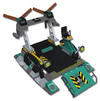 Cargo Carrier |
4 Energy Crystals | Rock Raider, Tool Store (L1), Teleport Pad (L1), Docks, Power Station (L1), Support Station (L2), Super Teleport (L1) | None |
| The Cargo Carrier is a large water-based vehicle that can transport certain small vehicles across water. Rock Raiders must be trained as Sailors to use it. | |||
| Tunnel Transport | None | Cannot be teleported | None |
| The Tunnel Transport is a large flying vehicle built to carry cargo and other vehicles. It cannot be used in the game and is only seen at the end of the mission Frozen Frenzy. | |||
Creatures
| Creature | Description | Damage |
|---|---|---|
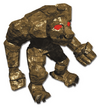 Rock Monster |
Rock Monsters | Laser Beam: 110 Pusher Beam: 2 (20u) Freezer Beam: 5 (25s) |
 Ice Monster |
Ice Monster | Laser beam: 110 Pusher Beam: 2 (60u) Freezer Beam: 0 |
 Lava Monster |
Lava Monster | Laser Beam: 1 Pusher Beam: 5 (60u) Freezer Beam: 40 (75s) |
 Slimy Slug |
Slimy Slug | Laser Beam: 5 Pusher Beam: 5 (60u) Freezer Beam: 0 |
 Bat |
Bat | None |
 Small Spider |
Small Spider |
Missions
LEGO Rock Raiders features twenty-five regular missions, as well as eight training missions.[1] The game's mission selection screen displays a cross-section of the alien planet, with individual missions represented as cavern openings.[12] Playable missions display an image of the mission in the cavern, while locked missions are dark and blocked by beams. Hovering the cursor over an available mission will display its name, and a completed mission will also display its completion status and the player’s achieved score for it. [12] Upon starting a new game, only the first mission can be played; completing it unlocks the missions below it. The deeper into the planet a mission is located, the more difficult it is intended to be.[1][12] The planet is divided into different-coloured layers, which are further divided into "levels" containing one to three missions in each. This was intended to give the game a branching mission path, allowing players to choose a different route through the game if they find a mission to be too difficult, or to replay the game following different paths than previously.[5][12] However, due to an oversight in the game's code, only missions on the left side of each level can unlock a route to the end of the game.[13] Training missions can also be played through a separate selection screen.[12]
Upon starting a mission, the character Chief presents a detailed briefing for the player, explaining the mission’s situation and objective.[3] Most mission objectives require the player to collect a certain amount of Energy Crystals, though other objectives can include constructing certain buildings, rescuing lost Rock Raiders, guiding Rock Raiders back to their base, or using dynamite to blast through Hard Rock.[4][2][1] The player is occasionally given clues as to how to accomplish their objectives, such as lost mining equipment found near the intended route, and Chief often gives further messages after an objective is achieved.[1] Once all objectives have been met, the mission ends, usually showing all of the player's units teleporting back to the Explorer.[4] Chief delivers a congratulatory message for completing the mission, and the player is shown a screen displaying their mission statistics and overall score; only at this point can the player save their progress.[4][1] If the player fails a level,
The table below lists the game's 33 missions,[3] arranged approximately as they are on the mission selection screen.
| Level | Missions | ||||||
|---|---|---|---|---|---|---|---|
| Brown (Tutorials) |
|||||||
| Yellow | 1 | Driller Night! | |||||
| 2 | |||||||
| 3 | |||||||
| Green | 4 | ||||||
| 5 | Frozen Frenzy | ||||||
| 6 | |||||||
| Blue | 7 | ||||||
| 8 | |||||||
| 9 | Lava Laughter | ||||||
| Purple | 10 | ||||||
| 11 | |||||||
| 12 | |||||||
| Red | 13 | Rocky Horror | |||||
Development
LEGO Rock Raiders was developed by Data Design Interactive, a British video game developer based in Halesowen, near Birmingham.[14] Development began in October 1997, shortly after the release of LEGO Island, when LEGO Media International approached Data Design to create it.[14][15] LEGO Media presented concepts for the then-upcoming LEGO Rock Raiders theme to the developers at Data Design, including ideas for the theme's characters, buildings, vehicles, creatures, and story.[16]: 9 At the time, Data Design had recently finished development on Conquest Earth, a strategy game made for Eidos Interactive.[17] The developers were looking to create another strategy game, and decided that the LEGO Rock Raiders storyline would work best as one.[16]: 2, 9
LEGO Media was heavily involved in the development of LEGO Rock Raiders.[16]: 10 Tomas Gillo, the head of concept development at LEGO Media,[18] became the game's senior producer.[19] David Upchurch, a producer for other LEGO Media titles, frequently visited Data Design for a week at a time to play through the game and give the developers feedback.[16]: 10 The project was managed on Data Design's end by Eamonn P. Barr, with founder Stewart Green credited as executive producer.[19]
Conception and design
For the first time in Lego history, children can play with the toy and then hop on the computer and play within the same Lego universe there. We hope that what they see and experience in the CG version will inspire them to go off and build and play with the toy, and vice versa.
Tomas Gillo, Computer Graphics World[18]
While previous LEGO video games had adapted from pre-existing LEGO themes, LEGO Rock Raiders was the first game to be developed in conjunction with LEGO construction sets. The LEGO Rock Raiders theme followed a new policy where development of the construction sets and the tie-in video game would influence each other, creating a larger universe for the whole theme.[18][20] LEGO Futura, the product development division of the LEGO Group, co-created the theme's concept with LEGO Media International, the company's software publishing branch.[14]
The unified development process of the toys and game led to some design issues, according to head artist Rob Dorney. Early in the game's design process, LEGO Futura would send storyboards and prototype LEGO models to the game's developers, who would give feedback on what worked with their vision for the game and make suggestions when ideas didn't work. Both groups often did not receive finalised model designs from the other until late in development.[18] Although the LEGO Rock Raiders construction sets took only eight months to develop,[20] the game's design process ended up lasting for around eighteen months, longer than usual for Data Design Interactive, as both groups had to adjust elements on their ends to create a cohesive product between the video game and LEGO sets. Despite these issues, the "parallel" development of the project was considered a success.[18]
The development team attempted to balance the gameplay of LEGO Rock Raiders to be challenging and fun while still being easy and accessible enough for young children to play. The inherent complexity of strategy games and the younger target audience of both the game and the LEGO Rock Raiders sets made finding this balance a challenge for the developers. The team designed the game to introduce players to new features gradually enough that they could improve their gameplay skills and prepare for later challenges without feeling overwhelmed.[16]: 10
The designers were not allowed to show any serious injuries, and could not make the game too violent or creepy. "We were very aware of the audience and of how violence is seen within the LEGO world," developer Karl White said in 2021.[16]: 10 Playable units in the game have health indicators (described in the manual as protective force fields or "Shields" surrounding them),[21] and Rock Raiders are safely teleported and back to the LMS Explorer when their health runs too low, rather than receiving any harm.[16]: 10 Despite this, players still felt a sense of attachment to their Rock Raiders and a fear of loss, according to White.[16]: 2 Creatures in the game also were revised multiple times to be appropriate for the game's target audience, and were designed to never be killed or destroyed, instead being pushed away by the player and eventually leaving.[16]: 10
Art and graphics

After being approached to develop LEGO Rock Raiders, Data Design Interactive set up a sister company, Artworld UK, to serve as a dedicated graphics and animation team for the game.[15] A team of twelve artists and animators at Artworld created most of the game's 3D models and animations with LightWave 3D, using a number of third-party plugins and running on high-end Windows NT workstations. Adobe Photoshop and Kai's Power Tools were used to create textures for the models.[18] Rob Dorney headed the art department at Artworld, while Dave Garbett headed animation.[15][19]
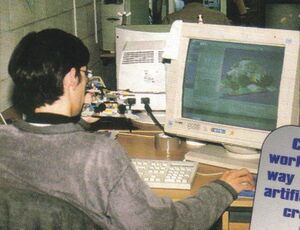
The virtual LEGO models used in the game were required to appear identical to the physical LEGO Rock Raiders sets.[22] Artworld artists took apart physical LEGO models and recreated each individual piece in LightWave 3D. The completed virtual LEGO pieces were added to a database, which LightWave could access using a set of plugins created by Artworld programmers. The colours used in the LEGO Rock Raiders sets were also programmed into the database. When artists needed to create a virtual LEGO construction, pieces from the database could be selected and coloured as needed. Once all of the desired pieces for a model were selected, another Artworld plugin generated a scene containing all of the coloured LEGO pieces, which the artists could assemble in the scene like a physical LEGO model.[18]
As the completed 3D models each contained thousands of polygons, which computers at the time running the game could not have handled in real-time, simplified versions had to be created for in-game use. Artists created new models with lower polygon counts, and used extensive texturing to maintain the appearance of LEGO pieces. Reflections, shadows, and lighting effects were used to make objects and textures appear more detailed than they were. Once completed, the LightWave models and animations could be directly loaded into the game's engine. The game ended up requiring a 3D accelerator card to run.[18]
The LEGO Rock Raiders sets used in the game were designed at LEGO Futura in Billund, Denmark, as were parts of the LMS Explorer spaceship seen in the game's FMV sequences.[22] The game's designers and artists decided which models in the sets would be used in the "LEGO Rock Raiders" game and what their characteristics would be.[23] The developers felt that the the sets weren't enough to create an "interesting gaming experience", according to Gillo. While the construction sets were limited by the number of pieces that could be included and the number of sets that could be produced and sold, the virtual world of the video game allowed for the creation of additional buildings, vehicles, characters, and environments.[18] Artists working on the game designed a number of game-exclusive buildings and vehicles, using the same LEGO elements as the Rock Raiders sets did, to create a more in-depth gaming experience and expand the Rock Raiders universe.[18][23]
The characters from the theme were also given additional development in the game, with each having unique animations and facial textures to give them all distinct personalities. The animators initially found it difficult to make the inanimate LEGO toys feel alive, particularly due to the stiff nature of LEGO minifigures. LEGO Media reluctantly allowed the animators to deviate from LEGO toy design rules by making the virtual minifigures more flexible. Minifigure models were given elbow and knee joints and torsos that could twist to allow for more realistic character movement.[18]
Sound and music
The characters in the game were voiced by Data Design Interactive employees. Chief was voiced by the game's project manager, while Jet was voice by the studio's office coordinator.[16]: 11
Three music tracks were composed by Marl Boonyer[a] and produced by Alan Boorman in 1998.[19][24]
Release
LEGO Rock Raiders was first publicly announced on 10 February 1999, along with LEGO Racers, LEGO Friends, and LEGOLAND. It was initially scheduled for release on Microsoft Windows and PlayStation in September 1999, with a planned retail price of US$40–$45.[25][26] It and LEGO Racers were intended to be the first LEGO video games for PlayStation,[25] and the first console LEGO games since LEGO Fun to Build in 1995.[citation needed] In May 1999 all four titles were displayed for demonstration at E3 1999 in Los Angeles, at the LEGO Media booth #1524 in the South Hall. A large LEGO model of the character Jet driving a Hover Scout was built by model designers from LEGO Systems during the event. Models of Rocket Racer's car from LEGO Racers and of PlayStation and Nintendo 64 controllers were also displayed at the LEGO Media booth; the controller models were given to the winners of a contest involving the car model.[27][28]
The game launched for Windows in November 1999.[16]: 11 LEGO Media announced the game's release and availability on 18 November.[29] IGN listed the game's release date as 15 November.[2] GameSpot listed a later release date of 30 November.[3]
Soundtrack
An extended play soundtrack, RockRaiders EP (originally titled RockRaiders Music), was released on Marl Boonyer's Bandcamp page "Temple Sound" on 23 August 2022. It was originally priced at £4 GBP, later lowered to £3 by December 2022, then made free on 18 April 2023.[24][30][31] The album contains the original masters of the three tracks that play during missions in the Windows version of the game.
| No. | Title | Length |
|---|---|---|
| 1. | "Rock" | 3:03 |
| 2. | "Ice" | 3:26 |
| 3. | "Lava" | 3:05 |
| Total length: | 9:35 | |
Reception
| Aggregator | Score |
|---|---|
| GameRankings | 65%[32] |
| Publication | Score |
|---|---|
| Adrenaline Vault | |
| Computer Games Strategy Plus | |
| GameSpot | 6.1/10[3] |
| IGN | 6/10[2] |
| PC Games (DE) | 72%[4] |
| PC Player | 68/100[33] |
| PC Zone | 44%[34] |
The game received mixed reviews according to the review aggregation website GameRankings.[32]
Legacy
In 2015, the magazine Retro Gamer listed LEGO Rock Raiders among games influenced by Bullfrog's Dungeon Keeper, stating that some people claimed it to be "the ultimate sequel to Dungeon Keeper."[35]
Write something about the game's modding scene, with links to pages about mods and modding.
In 2012, Data Design Interactive founder Stewart Green announced plans to develop a Rock Raiders sequel.[36]
Notes
- ↑ Credited as Mark Boobyer.
References
- ↑ a b c d e f g h i j k l Mandel, Bob (27 January 2000). "Rock Raiders". The Adrenaline Vault. Archived from the original on 5 July 2003.
- ↑ a b c d e f Lopez, Vincent (12 January 2000). "Strategy without the action, or how I learned to build and build and build and build". IGN. Ziff Davis. Archived from the original on 12 June 2000. Current version.
- ↑ a b c d e Park, Andrew Seyoon (28 January 2000). "LEGO Rock Raiders Review". GameSpot. CBS Interactive. Archived from the original on 6 February 2023 (Older archive from 20 June 2003).
- ↑ a b c d e Gliss, Sascha (März 2000). "Kumpel mit Plastikherz". PC Games. nur. 3/2000. Computec Media GmbH. p. 124. ISSN 0947-7810. Web version (Archived from the original on 8 February 2023).
- ↑ a b c d Finn, David (29 December 1999). "Lego Rock Raiders". Computer Games Strategy Plus. Strategy Plus, Inc. Archived from the original on 9 July 2003.
- ↑ Instruction Manual, p. 21.
- ↑ Instruction Manual, p. 19.
- ↑ a b Instruction Manual, p. 61.
- ↑ a b c d e Instruction Manual, pp. 60–61.
- ↑ a b Instruction Manual, p. 36.
- ↑ Instruction Manual, p. 68.
- ↑ a b c d e Instruction Manual, p. 13.
- ↑ Jordan, Robert [trigger_segfault] (13 June 2023). Fix #58: Properly unlock already-visited level links. OpenLRR. GitHub. Archived from the original in 22 June 2023.
- ↑ a b c Schwelling, Amy (17 May 1999). "LEGO Rock Raiders "Behind the Scenes..." for the LEGO World Club Magazine". LEGO Media internal memo. Retrieved 25 April 2023
- ↑ a b c Younghusband, Paul (February 2001). "A One Stop Digital Shop: Data Design Interactive and Artworld UK". Animation World Magazine. Vol. 5, No. 11. AWN, Inc. Archived from the original on 18 January 2023. Mirror available at Animation World Network.
- ↑ a b c d e f g h i j k Crecente, Brian; Vincent, Ethan (14 July 2021). "The Fans, Devs, and Remake of Real-Time Strategy Classic LEGO® Rock Raiders". Bits N' Bricks. The LEGO Group. Archived from the original on 19 January 2023.
- ↑ Jebens, Harley (September 18, 1997). "Conquest Earth Ships". GameSpot. Archived from the original on December 1, 1998. Retrieved 28 April 2023.
- ↑ a b c d e f g h i j k Moltenbrey, Karen (March 2000). "Legos Come to Life". Computer Graphics World. Volume 23, Issue 3. CGW Magazine. Archived from the original on 18 January 2023.
- ↑ a b c d Instruction Manual, pp. 86–87.
- ↑ a b Pickering, David; Turpin, Nick; Jenner, Caryn (eds.) (1999). "The Design Concept". The Ultimate LEGO Book. DK publishing. pp. 30–31. ISBN 0-7894-4691-X.
- ↑ Instruction Manual, p. 58.
- ↑ a b Yeo, Matt (ed.) (October 1999). "Behind the Scenes: Rock Raiders". LEGO Adventures!. Issue 7. Egmont Fleetway Ltd. pp. 30–33. ISSN 1465-0738.
- ↑ a b Staff (August 1999). "Danger Underground". Bricks 'n' Pieces. Issue 70. LEGO UK Ltd. pp. 4–5.
- ↑ a b Boonyer, Marl (23 August 2022). RockRaiders Music by Temple Sound. Bandcamp. "Composed and produced in 1998 by Marl Boonyer & Alan Boorman". Archived from the original on 26 August 2022.
- ↑ a b Fudge, James (10 February 2009). "LEGO Announces 4 New Titles". Computer Games Strategy Plus. Strategy Plus, Inc. Archived from the original on 29 November 2002.
- ↑ IGN Staff (11 February 1999). "It's a Snap". IGN. Ziff Davis. Archived from the original on 18 January 2023 (Older archive from 1 September 2000).
- ↑ Fudge, James (11 May 1999). "Lego Media at E3". Computer Games Strategy Plus. Strategy Plus, Inc. Archived from the original on 29 November 2002.
- ↑ IGN Staff (11 May 1999). "Lego Media's E3 Lineup". IGN. Ziff Davis. Archived from the original on 18 January 2023 (Older archive from 9 March 2000).
- ↑ McClendon, Bill (18 November 1999). "And Then There Were Three". Gamecenter. CNET. Archived from the original on 26 February 2000.
- ↑ Boonyer, Marl (23 August 2022). RockRaiders EP by Temple Sound. Bandcamp. Archived from the original on 9 December 2022. The price has been lowered to £3 GBP from the previous archive in late November.
- ↑ Boonyer, Marl (18 April 2023). Email sent from Temple Sound's Bandcamp. "Hello everyone. Many thanks for your generosity. Helped me through a very tough period. All tracks are now free. marl". Archived from the original on 19 April 2023.
- ↑ a b "LEGO Rock Raiders for PC". GameRankings. CBS Interactive. Archived from the original on 27 May 2019. Retrieved 13 May 2023.
- ↑ Werner, Thomas (January 2000). "Rock Raiders". PC Player. No. 1/2000. Future Verlag p. 183.
- ↑ Lyon, James (April 2000). "Lego Rock Raiders". PC Zone. No. 88. Dennis Publishing. p. 91.
- ↑ Crookes, David (18 June 2015). "The Making Of Dungeon Keeper". Retro Gamer. No. 143. Imagine Publishing Ltd. p. 69. ISSN 1742-3155.
- ↑ Green, Stewart [StewartG] (26 August 2012). "DDI looking for help with new Rock Raiders title". Rock Raiders United. Archived from the original on 18 January 2023. Original topic name archived 26 July 2013.
Sources
- McPhail, Jim (13 December 1999). LEGO Rock Raiders Instruction Manual (UK FRONT, BACK, I/F & I/B COVER). LEGO Media International. Serial: IB2G-ROC3 2299598.
- Data Design Interactive (last modified 25 September 1999). Main Lego Config File. File path: Rock Raiders\LegoRR1.wad\Lego.cfg.
